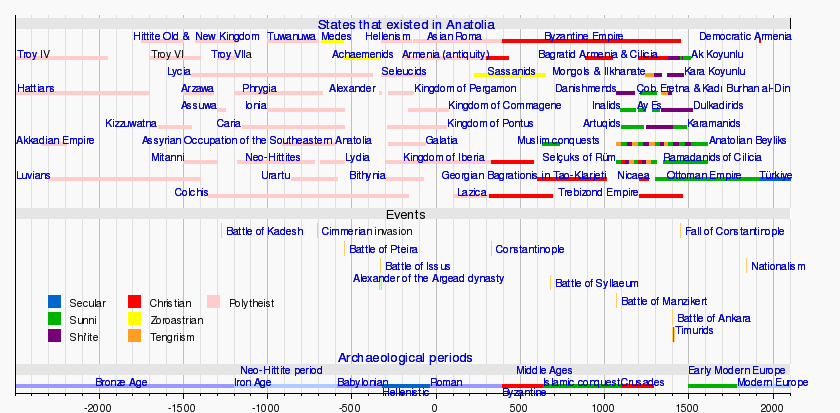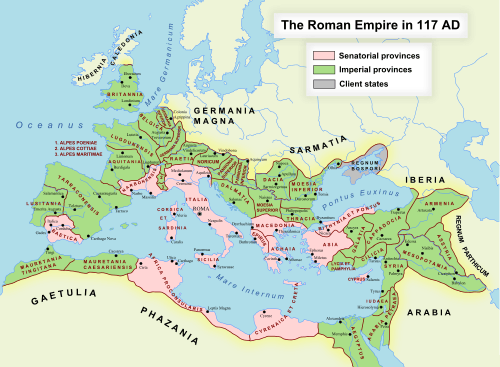Lesser Armenia
Lesser Armenia (Armenian: Փոքր Հայք Pokr Hayk), also known as Armenia Minor and Armenia Inferior, refers to the Armenian populated regions, primarily to the west and northwest of the ancient Armenian Kingdom (or "Greater Armenia"). The region was later reorganized into the Armeniac Theme under the Byzantine Empire.
Geography
Lesser Armenia (or Armenia Minor) was the portion of historic Armenia and the Armenian Highlands lying west and northwest of the river Euphrates. It received its name to distinguish it from the much larger eastern portion of historic Armenia—Greater Armenia (or Armenia Major).
Initial history

Early history
Prior to 4th century BC, the territory of Lesser Armenia was part of the ancient Armenian Kingdom, which was ruled by the royal dynasty of Orontids (Yervanduni, Armenian: Երուանդունի) and, in the 4th century BC, was subject to the Persian Achaemenid Empire.
Following the campaigns of Alexander the Great in 330s BC, as the Persian Empire collapsed, Mithridates, an Armenian general of the Persian army, declared himself king of Lesser Armenia, more generally known as the Kingdom of Pontus. Thus two independent kingdoms emerged from the territory of the ancient Armenian kingdom—the Kingdom of Pontus and Greater Armenia. By the 3rd century BC, the Kingdom of Pontus reached its greatest extent and covered also the territories of southeastern coasts of the Black Sea, including the provinces of Trapezus, Rizon and Hamshen (the area where the ethnic Armenian Hamshenis originated).
Roman-Persian wars

Armenia was disputed kingdom between Rome and Parthia during the Roman-Persian Wars from 66 BC to the 2nd century AD. Roman influence was first established with Pompey's campaign of 66/65 BC, and again in 59 AD in the Roman–Parthian War campaign of Gnaeus Domitius Corbulo; which resulted in the deposition of Tiridates I.
Roman and Byzantine Lesser Armenia
All of Armenia became a Roman province in AD 114 under Roman emperor Trajan, but Roman Armenia was soon after abandoned by the legions in 118 AD and became a vassal kingdom. Romans lost Armenia again to Vologases IV of Parthia in AD 161. In 163, a Roman counter-attack under Statius Priscus once again installed a favoured candidate on the throne of Armenia, and Roman influence in Armenia remained until the Roman temporary defeat at the Battle of Barbalissos in 253. But a few years later, at the end of the 3rd century, Rome was again in control of Armenia and successively promoted the Christianization of all Armenia.
Lesser Armenia was reunited with the kingdom of Greater Armenia under the Arshakuni king Tiridates III in AD 287, until the temporary conquest of Shapur II in 337.
Then it was formed into a regular province under Diocletian, and in the 4th century, was divided in two provinces: First Armenia and Second Armenia.
Its population remained Armenian, but was being gradually Romanized. Since the 3rd century many Armenian soldiers were in the Roman army: later–in the 4th century–they made up two Roman legions, the Legio I Armeniaca and the Legio II Armeniaca.[1]
In 536, the emperor Justinian I reorganized the provincial administration, and First and Second Armenia were renamed Second and Third respectively, while some of their territory was split off to the other Armenian provinces.
The borders of the Byzantine part of Armenia were expanded in 591 into Persarmenia, but the region was the focus of decades of warfare between the Byzantines and the Persians (the Byzantine-Sassanid Wars) until the Arab conquest of Armenia in 639.
After this, the part of Lesser Armenia remaining under Byzantine control (in a lesser extent) became part of the theme of Armeniakon.
Mongol and Ottoman influence
After the downfall of Bagratid Armenia in 1045 and resulting subsequent losses of Byzantine Empire in the East in 1071 (after the Battle of Manzikert), Lesser Armenia fell to the Seljuks and then was parts of Mongol Empire for 92 years and Ottoman Empire for the entire duration of the latter's existence.
Between the 11th and 14th centuries the term Lesser Armenia (sometimes called "Little Armenia") was applied to the Armenian Kingdom of Cilicia, until the formation of Turkey in 1923.
Episcopal sees
Ancient episcopal sees of the Roman province of Armenia I listed in the Annuario Pontificio as titular sees:[2]
- Berissa
- Colonia in Armenia (Köylühisar)
- Nicopolis in Armenia
- Pedachtoë (Bedochton, Pedachton)
- Satala in Armenia
- Sebaste
- Sebastea
- Sebastopolis in Armenia
Ancient episcopal sees of the Roman province of Armenia II listed in the Annuario Pontificio as titular sees:[2]
- Arabissus
- Arca in Armenia (Arga)
- Ariarathia
- Comana Armeniae (Sar or Sarkale)
- Cucusus
- Melitene
- Verissa
For ancient episcopal sees of the Roman province of Armenia III, see Roman Armenia#Episcopal sees.
Later history
Lesser Armenia is traditionally considered as part of Western Armenia, especially after the acquisition of Eastern Armenia by the Russian Empire in the aftermath of the Russo-Turkish War of 1829.
The Christian Armenian population of Lesser Armenia continued its existence in the area until the Armenian Genocide of 1915-23. Some Armenians still live in the area, albeit converted to muslim religion under Ottoman influence, mainly in the 17th century.[3]
See also
- Hemshinli
Notes
- ↑ Legio II Armeniaca
- ↑ 2.0 2.1 Annuario Pontificio 2013 (Libreria Editrice Vaticana 2013 ISBN 978-88-209-9070-1), "Sedi titolari", pp. 819-1013
- ↑ Armenian History and Presence in Hemşin
- References
- Bert Vaux, Hemshinli: The Forgotten Black Sea Armenians, Harvard University, 2001.
- Mack Chahin, The Kingdom of Armenia: A History, Routledge, London, 2001. (ISBN 0-7007-1452-9)
- Robert H. Hewsen, Armenia: A Historical Atlas, University Of Chicago Press, 2000. (ISBN 0-226-33228-4)
| ||||||||||||||||||||||||
| ||||||
| ||||||||
| ||||||||||||||||||||||||||||||||||||||||||||||||||||||||||||||||||||||||||



